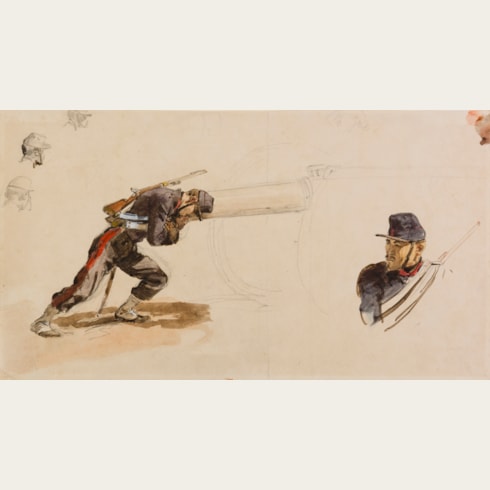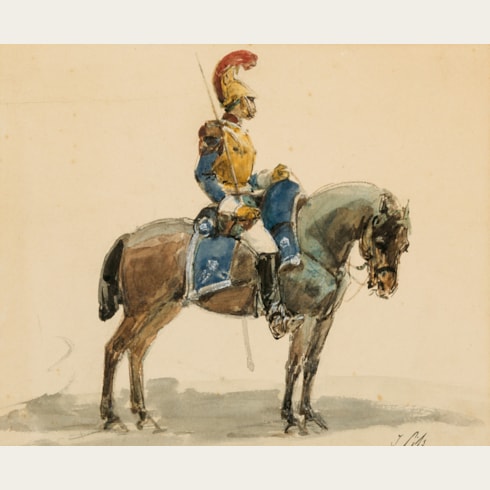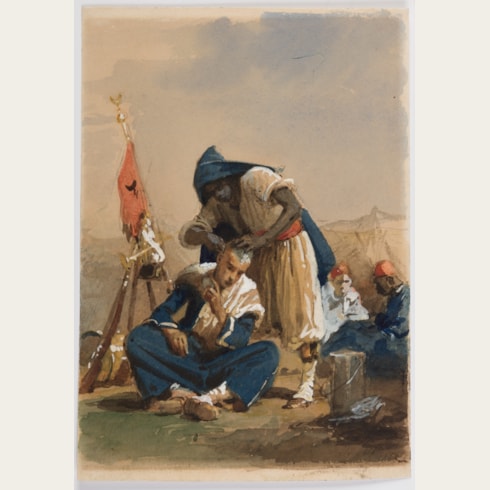Isidore PILS
(Paris 1813 - Douarnenez 1875)
Studies of a Woman Holding a Bowl
Red chalk, heightened with touches of white chalk, on buff paper.
363 x 265 mm. (14 1/4 x 10 3/8 in.)
363 x 265 mm. (14 1/4 x 10 3/8 in.)
This drawing is a preparatory figure study for the artist’s large canvas of Soldiers Distributing Bread and Soup to the Poor, painted in 1852 and exhibited at the Salon that year. Commissioned by the State for the sum of 4,000 francs, the painting is today in the collection of the Château de Fontainebleau. (Long thought to be lost, the painting was for many years known only through a lithographic reproduction published in the magazine L’Illustration in 1852.) The scene depicts a military soup kitchen in 1849, and may have been based on the artist’s own observations of a similar scene in the Champ des Invalides in central Paris. As Gabriel Weisberg has noted of the painting, ‘the work was considered by some art critics to be an extremely appropriate subject for the times. In recording the interaction of the military with the people of Paris to forestall hunger in 1849, the painting suggests that three years later in 1852, the military (and by implication, the government) was still dedicated to relieving the sufferings of the poor…This commission demonstrates Pils’ penchant for working within the system and portraying the policies of the Second Empire.’ Soldiers Distributing Bread and Soup to the Poor was later exhibited at the Exposition Universelle of 1900.
Pils made numerous drawings, watercolours and oil sketches in preparation for each of his paintings, and particularly for individual figures within a composition. The importance of this particular commission is reflected in the number of preparatory studies for Soldiers Distributing Bread and Soup to the Poor that are known. Indeed, the posthumous sale of the contents of the artist’s studio in 1876 included several studies for the picture, including three compositional drawings, nine studies of the soldiers, and thirteen drawings of people in the crowd.
Weisberg has noted that ‘Even in the preliminary drawings Pils had a firm idea of how all the figures would be placed in the final painting. He reconstructed the scene with models, whom he either posed in his studio or on the street in order to capture the accuracy that a realist theme demanded…Once he had satisfactorily determined the placement of a figure in an overall scheme, Pils rendered the subtle nuances of facial expressions…[The] studies for Soldiers Distributing Bread to the Poordemonstrate how the artist enlarged the role of drawings in his creative process. Preliminary sketches first helped him conceptualize his compositional scheme, while more developed drawings were used to position key figures and crystallize their attitudes…The existence of these various types of drawings with their different purposes in the evolution of his final image proves that Pils followed a specific method as he constructed his realism. Many of his drawings function as part of a large series and bring his realism extremely close to the academic tradition.’
The present sheet is a study for the mother and child at the centre of the composition of Soldiers Distributing Bread and Soup to the Poor. A smaller preliminary sketch in red chalk for the same figure, although not holding a bowl, is in a private American collection.
Pils often found his models in the poorest quartiers of Paris. As he wrote, it was ‘in the streets...among the people that one could find types and models; and in this way historic painting could become true and human’.
Pils made numerous drawings, watercolours and oil sketches in preparation for each of his paintings, and particularly for individual figures within a composition. The importance of this particular commission is reflected in the number of preparatory studies for Soldiers Distributing Bread and Soup to the Poor that are known. Indeed, the posthumous sale of the contents of the artist’s studio in 1876 included several studies for the picture, including three compositional drawings, nine studies of the soldiers, and thirteen drawings of people in the crowd.
Weisberg has noted that ‘Even in the preliminary drawings Pils had a firm idea of how all the figures would be placed in the final painting. He reconstructed the scene with models, whom he either posed in his studio or on the street in order to capture the accuracy that a realist theme demanded…Once he had satisfactorily determined the placement of a figure in an overall scheme, Pils rendered the subtle nuances of facial expressions…[The] studies for Soldiers Distributing Bread to the Poordemonstrate how the artist enlarged the role of drawings in his creative process. Preliminary sketches first helped him conceptualize his compositional scheme, while more developed drawings were used to position key figures and crystallize their attitudes…The existence of these various types of drawings with their different purposes in the evolution of his final image proves that Pils followed a specific method as he constructed his realism. Many of his drawings function as part of a large series and bring his realism extremely close to the academic tradition.’
The present sheet is a study for the mother and child at the centre of the composition of Soldiers Distributing Bread and Soup to the Poor. A smaller preliminary sketch in red chalk for the same figure, although not holding a bowl, is in a private American collection.
Pils often found his models in the poorest quartiers of Paris. As he wrote, it was ‘in the streets...among the people that one could find types and models; and in this way historic painting could become true and human’.
Born into a family of artists, Isidore-Alexandre-Augustin Pils was a student of François-Edouard Picot at the Ecole des Beaux-Arts. He won the Prix de Rome in 1838 and spent the next five years in Italy, until 1844. The early part of his career was taken up with mostly religious subjects, although he began to paint military scenes after the Crimean war, in which he acted as an observer. His success as a military painter led to further commissions, including a number of paintings for Napoleon III. One of the artist’s most important paintings, Soldiers Distributing Bread and Soup to the Poor, was commissioned by the State for the sum of 4,000 francs and was exhibited at the Salon of 1852. (The painting has since been lost, and is known only through a lithographic reproduction.) In 1857 a large canvas of a major Crimean episode, The Passage of the River Alma, was commissioned for Versailles.
Pils was also interested in scenes from modern history, exemplified by his famous painting of Rouget de Lisle Singing the 'Marseillaise', exhibited to popular acclaim at the Salon of 1849. Pils also executed a number of paintings for Parisian churches - notably the decoration of the chapel of Saint André in the church of Saint Eustache, painted between 1849 and 1852 and still in situ - and took part in the mural decoration of the Opéra. In 1864 he was appointed a Professor at the École des Beaux-Arts, and made several watercolours of life in Paris during the Prussian siege of the city in 1871.
Pils made numerous drawings, watercolours and oil sketches in preparation for each of his paintings, and particularly for individual figures within the composition. He made his first watercolours of military subjects in the early 1850s, when he began to make studies of soldiers encamped at Vincennes, near Paris.
Pils was also interested in scenes from modern history, exemplified by his famous painting of Rouget de Lisle Singing the 'Marseillaise', exhibited to popular acclaim at the Salon of 1849. Pils also executed a number of paintings for Parisian churches - notably the decoration of the chapel of Saint André in the church of Saint Eustache, painted between 1849 and 1852 and still in situ - and took part in the mural decoration of the Opéra. In 1864 he was appointed a Professor at the École des Beaux-Arts, and made several watercolours of life in Paris during the Prussian siege of the city in 1871.
Pils made numerous drawings, watercolours and oil sketches in preparation for each of his paintings, and particularly for individual figures within the composition. He made his first watercolours of military subjects in the early 1850s, when he began to make studies of soldiers encamped at Vincennes, near Paris.
Provenance
The vente Isidore Pils, Paris, Hôtel Drouot [Durand-Ruel & Mannheim], 20 March-1 April 1876, probably part of lot 844 (‘Figures diverses pour la ‘Distribution du pain aux indigents’: Dix feuilles, sanguine et crayon noir’).








